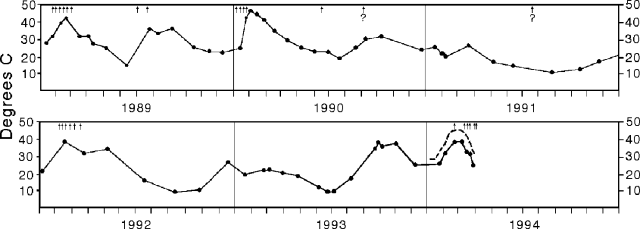Report on Ruapehu (New Zealand) — October 1993
Bulletin of the Global Volcanism Network, vol. 18, no. 10 (October 1993)
Managing Editor: Edward Venzke.
Ruapehu (New Zealand) Temperature of crater lake increases, generating high steam plumes
Please cite this report as:
Global Volcanism Program, 1993. Report on Ruapehu (New Zealand) (Venzke, E., ed.). Bulletin of the Global Volcanism Network, 18:10. Smithsonian Institution. https://doi.org/10.5479/si.GVP.BGVN199310-241100
Ruapehu
New Zealand
39.28°S, 175.57°E; summit elev. 2797 m
All times are local (unless otherwise noted)
The crater lake temperature has increased sharply since early July, and by late September had reached levels at which small phreatic events have previously occurred (figure 15). Numerous reports of high steam columns in September generated public and media speculation, but there was no significant eruptive activity.
Steam clouds, possibly to heights of 400 m above the summit, were seen on 20 September from Taupo, ~75 km NE. Geologists who visited the volcano on 21 September observed a steam cloud rising up to 500 m above the lake, preventing observations of possible upwelling over the main vent. Dense steam covered much of the central part of the turbid gray lake; light steam was present along the shore. In the N vent area, a large but weak upwelling cell was defined by a semicircular yellow-gray slick with several smaller cells nearby. Large slicks were observed drifting towards the outlet. There were no waves except those caused by occasional falls from ice cliffs on the N shore, and no evidence of surging on the beach or in the outlet channel. The snowline N of the lake had melted back from the shore because of steam and sunlight. During the next visit, on 29 September, the lake was still a turbid gray color, but only minor steam was coming from the surface. Very slight convection was seen at three sites in the N vent area, with no upwelling or slicks noticed until the early afternoon, when a brief period of upwelling over the main vent took place with associated black slicks. No surging or high lake levels had occurred since the 21 September visit.
Following a period of slow cooling from February to early July the lake temperature again began to increase, accompanied by a decrease in discharge (see table 3). By 29 September the falling lake was 16 cm below the overflow level (no discharge) and the temperature was 38.2°C. Lake water analyses since 18 June showed a minor increase in Mg content (~3%), but about an 11% increase in Cl content (see table 3). This is consistent with either the injection of HCl-bearing steam into the lake, expulsion of a vent condensate that did not interact significantly with fresh andesite, or a mixture of these fluids.
EDM distance changes between 6 August and 21 September were insignificant, with the possible exception of a 9 mm lengthening of a line that runs from the N to the SW side of the lake, reversing the previous trend. Variable levels of volcanic tremor in the 2-3 Hz range continue to be recorded. Long-duration earthquake swarms were recorded on 11 and 17 September, but neither was associated with significant eruptive activity.
Geological Summary. Ruapehu, one of New Zealand's most active volcanoes, is a complex stratovolcano constructed during at least four cone-building episodes dating back to about 200,000 years ago. The dominantly andesitic 110 km3 volcanic massif is elongated in a NNE-SSW direction and surrounded by another 100 km3 ring plain of volcaniclastic debris, including the NW-flank Murimoto debris-avalanche deposit. A series of subplinian eruptions took place between about 22,600 and 10,000 years ago, but pyroclastic flows have been infrequent. The broad summait area and flank contain at least six vents active during the Holocene. Frequent mild-to-moderate explosive eruptions have been recorded from the Te Wai a-Moe (Crater Lake) vent, and tephra characteristics suggest that the crater lake may have formed as recently as 3,000 years ago. Lahars resulting from phreatic eruptions at the summit crater lake are a hazard to a ski area on the upper flanks and lower river valleys.
Information Contacts: P. Otway, IGNS Wairakei.


